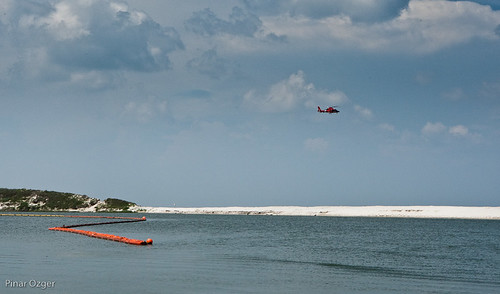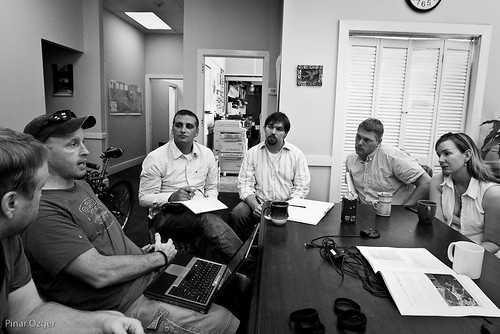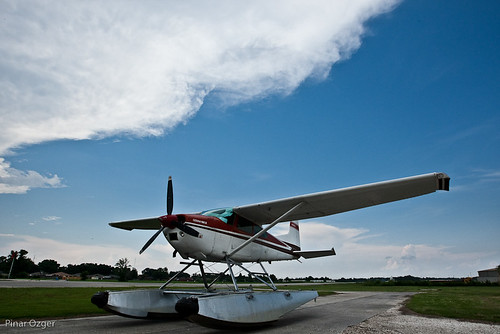Day 3: Note from the Field by Darron Collins
5:15am
The plan for the morning was to storm the Port Perdido beach before sunrise and before the waste management crews arrived. It felt a bit like a military operation until we arrived at the water and stood together silently with a few herons watching the waves gently lap the shore. The heron’s neck is folded when flying but is a more elongated “s” when not. Standing, the heron contemplated the waves. Standing, we five contemplated the cleanliness of the beach. We saw some evidence of oil yesterday afternoon and expected to find the night’s waves and winds to have deposited near shore oil all over the beach. It didn’t. Or did it and we just didn’t see it?
Several miles down the beach we saw hundreds of workers poised to attack the sands with rakes and shovels. We saw tire tracks on the sand from the night crews that worked the beaches. We saw the Coast Guard helicopters buzzing the shores. We saw no oil.
Here’s what’s going on in this part of the Gulf, as far as I can tell:
- There’s a huge mass of oil 3-5 miles off the coast. That seems real close until your standing right at the water’s edge looking for it.
- Loops and edges of that mass are peeled off by wind and currents and wave action and are deposited somewhere along this 70 or so mile stretch of beach between the Pelican Bay cut of Mobile Bay and Pensacola, Florida.
- The Coast Guard helicopters buzz that stretch of sand every morning at daybreak and radio in points most likely to receive oil during the day.
- Busloads of workers are brought from the surrounding hotels and are transported to the most strategic locations on the beach and hit the oil with a vengeance.
- Night crews continue the fight.
According to folks who have done low-altitude flyovers of these easternmost shores, there’s A LOT of oil out there. I don’t want to minimize the potential damage that oil can do or minimize the damage its somewhat hidden presence has already done to the tourism industry here, but…
[sidebar: The waitresses at Waffle House are filing individual claims to BP. Counter traffic and tips are down because of low tourism volume and because BP provides meals for workers]
…but, there seems to be a REALLY high level of investment and organization here and, at least superficially, things look pretty good.
***
10:00am
We are learning creatures and have learned to plan any kind of driving between 10 and 2 to avoid the thickest heat of the day (an obvious poor light). From Perdido and Orange Beaches Alabama we made our way back west to New Orleans for a staff briefing with the Gulf Restoration Network.
2:00pm
GRN’s offices are in New Orleans’ CBD, the Central Business District, up on the second floor of a Baronne Street office building — great digs just a stones throw from Canal Street. Their team is about 15 or so strong and is on the front lines of this situation. Thank God they are. Thank God a group like this is dedicating everything they’ve got to staying on top of things down here and making sure the world knows about the little blips and larger blurps that might get brushed underneath the rug. Thank God for GRN.
It was good to touch base again with Jonathan Henderson, who has join and/or led me on some great adventures down here. And it was great to also have met Casey DeMoss Roberts, GRN’s Assistant Director of Water Resources, who will be traveling north next week to present at TEDxOilSpill. We MUST be sure that local voices are heard at that event and Casey’s voice is a great place to start.
***
4:00pm
Following a press interview with a network affiliate down here in New Orleans and a radio interview with ABC radio in Australia, we crossed the Big Muddy to the West Bank (affectionately known as the Best Bank) to meet up with our friends at Southern Sea Plane. Duncan will tell you more about that but suffice to say the team is FIRED UP to get in the air tomorrow and have a look at what’s going on from 3000 and 1500 feet.
***
7:00pm
By now blood sugar levels in the groups were crashing and sentences weren’t making any sense anymore. It had been 14 hours since we roused in Orange Beach, Alabama and we were in desperate need of some MUD BUGS (crawdaddies) to regain our strength. Tomorrow would be another huge day and the team would have to split up for the first time to cover more ground: Duncan, Kris and Pinar heading for the airstrip, Danielle and I making a drive to Baton Rouge to document a rally on the State Capitol. Then we’ll recollect and head down to Grand Isle, LA.
(Photos in this post by Pinar Ozger)





